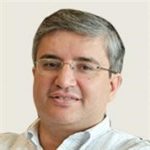Mohamed-Slim Alouini
Title:
Paving the Way Towards 5G Wireless Communication Networks
Affiliation:
Computer, Electrical, and Mathematical Science and Engineering (CEMSE) Division
King Abdullah University of Science and Technology (KAUST)
Thuwal, Makkah Province, Saudi Arabia.
Bio:
Mohamed-Slim Alouini (S’94, M’98, SM’03, F’09) was born in Tunis, Tunisia. He received the Ph.D. degree in Electrical Engineering from the California Institute of Technology (Caltech), Pasadena, CA, USA, in 1998. He served as a faculty member in the University of Minnesota, Minneapolis, MN, USA, then in the Texas A&M University at Qatar, Education City, Doha, Qatar before joining King Abdullah University of Science and Technology (KAUST), Thuwal, Makkah Province, Saudi Arabia as a Professor of Electrical Engineering in 2009.
Prof. Alouini is a Fellow of the Institute of Electrical and Electronics Engineers (IEEE), a member of the Thomson ISI Web of Knowledge list of Highly Cited Researchers and of the Elsevier/Shanghai Ranking list of Most Cited Researchers, and an IEEE Distinguished Lecturer of the IEEE Communications Society. He is a recipient of the Recognition Award of the IEEE ComSoc Wireless Technical Committee in 2016 and a co-recipient of best paper awards in ten IEEE conferences (including ICC, GLOBECOM, VTC, PIMRC, and DySPAN). His current research interests include the modeling, design, and performance analysis of wireless communication systems.
Abstract:
5G wireless communication networks are expected to fulfill the demand for higher data rates, lower latency, and/or massive connectivity of a growing number of users/devices exploiting a variety of wireless applications. This envisioned rapid increase in the use of wireless services lead the wireless research community to start looking at new technologies to address problems related to the radio-frequency (RF) spectrum exhaustion. This includes the development of (i) new techniques and concepts such as massive multiple input multiple output (MIMO) systems and heterogeneous networks to improve the spectral efficiency at the link and network layers, respectively, and (ii) novel schemes to better utilize the unregulated bandwidth in particular in the upper millimeter wave, THz, and optical portion of the spectrum. This talk will first go briefly over the vision and goals of 5G wireless communication networks. Then it presents some of these emerging enabling technologies that need to be developed to pave the way towards the successful roll-out and operation of these future wireless networks. Finally, the talk offers at the end an overview of some of the recent results in the areas of massive MIMO systems, full-duplex communication systems, and optical (Li-Fi) wireless communication systems.
